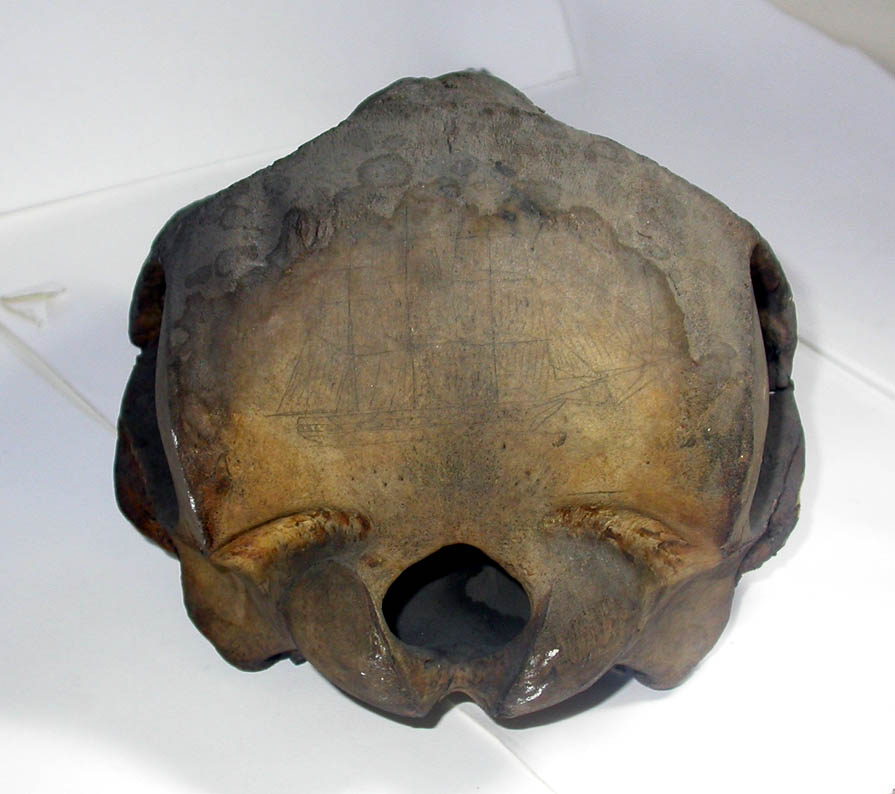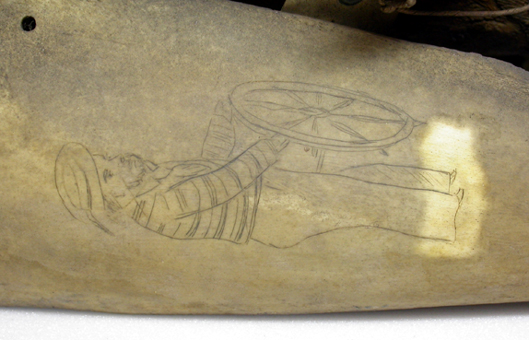Cleaning a very dirty dolphin skull and mandible to reveal scrimshaw, for the University of Cambridge’s Museum of Zoology.
This complete skull and mandible of a rough-toothed dolphin was donated to the museum in 1872 so is at least 141 years old. It has two clear examples of scrimshaw engraving: one towards the rear of the right mandible depicting a sailor at the wheel of a ship (fig1), and the other depicting a fully rigged ship in full sail, towards the top of the rear of the skull (fig2). The former had clearly been ‘inked-in’ with a black product but the latter was not so well defined and was also more crude in its execution. Unfortunately, the specimen was really quite dirty with dust and dark sooty particulates (figs 1, 2, 3 & 4) and this obscured the detail of the scrimshaw and looked very unsightly. In addition, it was clear that an attempt had been made in the past to clean the rear of the skull with water but this had just made a mess (fig 4). The specimen had to be cleaned with an appropriate conservation treatment that would not only clean the bone, remove the dirt and do no harm to the bone surfaces but importantly would not wash away the ‘ink’ that had been applied to the thin carved lines of the scrimshaw.
1 2
2 3
3 4
4
From past experience it was judged that the most effective way of gently cleaning the bone of the unsightly residues without liberating and mobilising the ‘ink’ (and thereby spreading it and/or removing it) was to swab small areas with cotton wool pads lightly dipped in a mild conservation detergent diluted with water, followed by a swab with cotton wool pads dipped in just water to remove the detergent from the bone. This was followed by swiftly drying the area with a paper towel.
A test area of bone was cleaned using this method, deliberately not directly on the scrimshaw. As this was successful (fig 5) a small area of scrimshaw was also very gently cleaned (fig 6). The ink was not liberated and mobilised so the technique was deemed a success. The rest of the specimen was cleaned in this manner, patting each area of the bone gently with paper towels to dry it as soon as it had been cleaned, so that the small amounts of water had little chance to soak into the bone. This was to reduce the chances of the bone warping and/or splitting due to the sudden wetting (though it was really just a very temporary dampening). Figs 7 & 8 show the cleaning processes half way through.
5 6
6 7
7 8
8
The whole specimen is now much cleaner and the scrimshaw images can be seen much more easily and can be studied properly (figs 9, 10 & 11). Also, there are many dozens of cut-marks now visible, presumably from the de-fleshing of the skull.
9 10
10
11
For more details about what we can do for you, or for a quote, please
contact:
enquiries@natural-history-conservation.com
We
are members of the United Kingdom Institute for Conservation of Historic and
Artistic Works